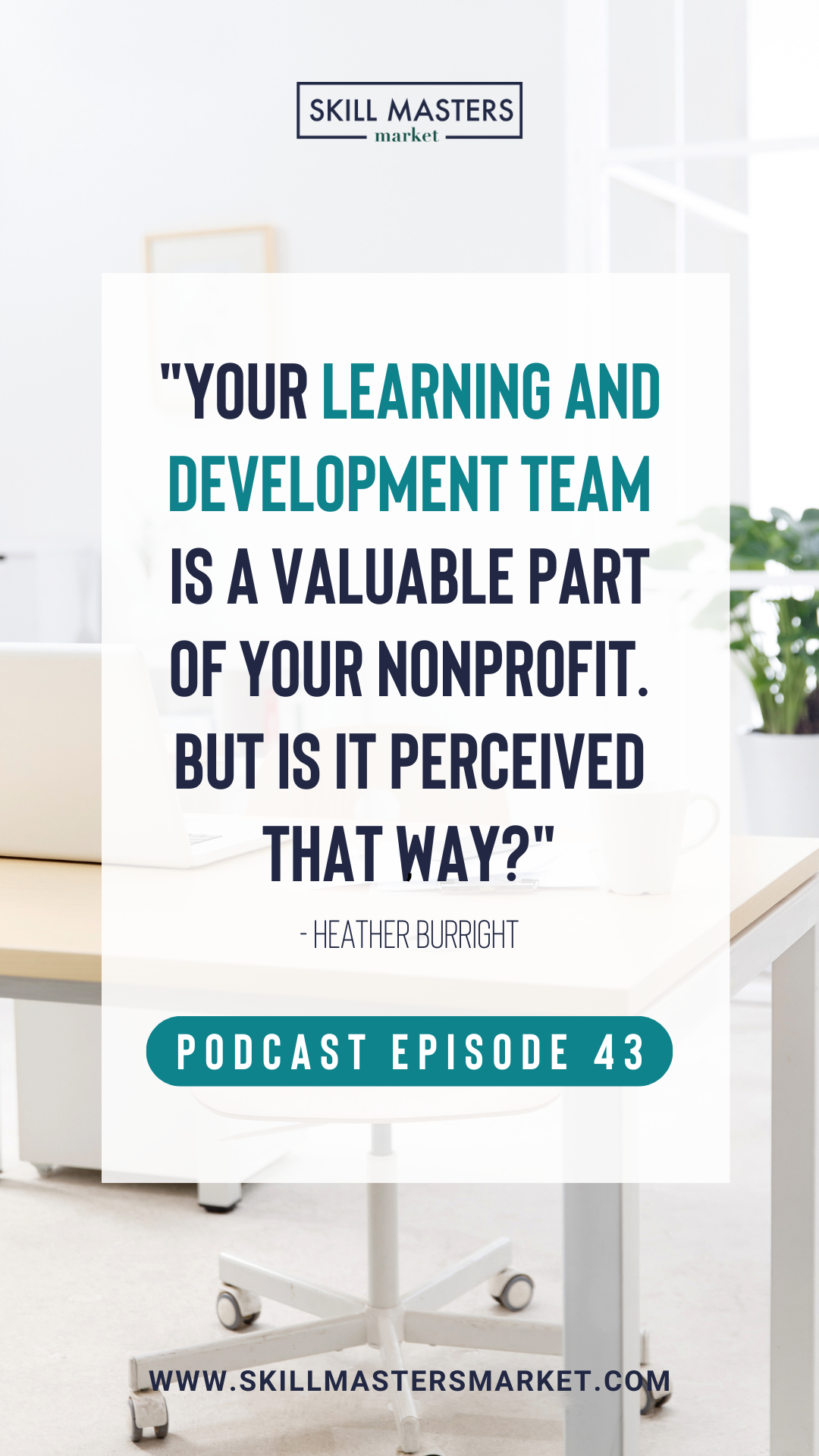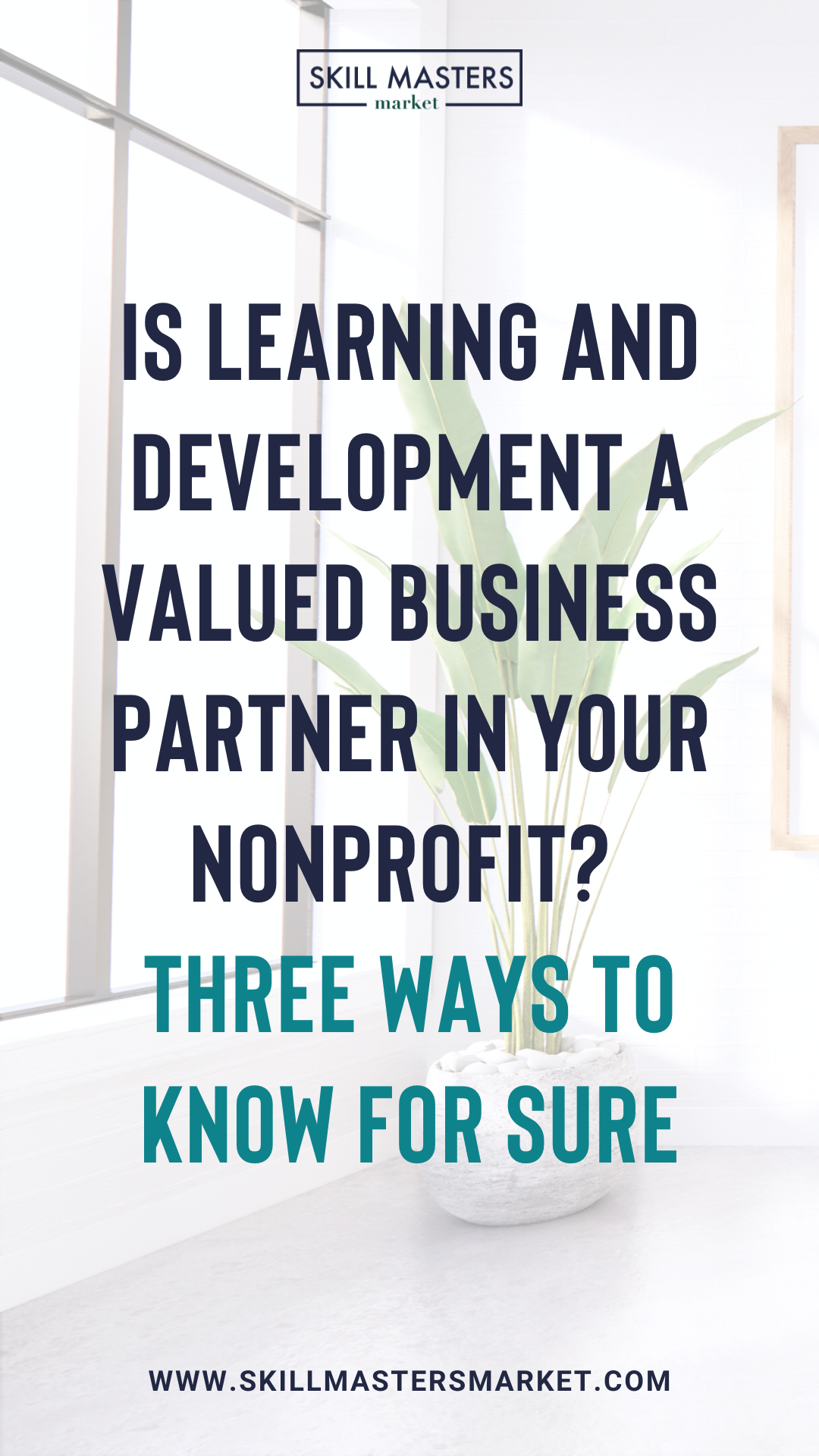Is Learning and Development a Valued Business Partner in Your Nonprofit? Three Ways to Know For Sure
In our house, we have a good couch and an everyday couch. Our good couch is taken care of. And it's lasted for years. Then we have our everyday couch. It's also used to watch movies or lounge around on. But we are a little less careful about spilling popcorn on it and kids jumping on it. This couch is also part of our story, but we don't expect it to last as long.
It's easy to know which couch is more valuable. It's the one we care for. But is it that easy to know if your Learning and Development team is a valued business partner at work? That's what we're going to explore in today's episode.
Listen to the episode or scroll down to read the blog post ↓
Key Points:
03:02 Referring team members to Learning and Development when skill gaps are noticed
04:35 Including Learning and Development when senior leaders are making operational decisions
05:15 Proactively identifying what resources Learning and Development needs to support the overall project
Click here to listen on Apple Podcasts. While you're there, subscribe to be the first to know about new episodes!
Is Learning and Development a Valued Business Partner in Your Nonprofit? Three Ways to Know For Sure
In our house, we have a good couch and an everyday couch.
Our good couch is taken care of, and it's lasted for years.
We've sat on it, we watched movies there, we've snuggled up under blankets on cold winter nights, we've fed babies, we've wiped away tears after nightmares jolted one of our kids awake. It's always there. And we want it to last. So we take care of it.
Then we have our everyday couch.
It's also used to watch movies or lounge around. But we are a little less careful about spilling popcorn on it, kids jumping on it, and the dog climbing up for pets. This couch is also part of our story, but we don't expect it to last as long. We paid less for it and we're just a little less protective of it.
So why am I telling you about my couches?
It's easy to know which couch is more valuable. It's the one we care for. But is it that easy to know if your Learning and Development team is a valued business partner at work?
I want you to think about something you value. Maybe it's something that was really expensive. Maybe it's something that has sentimental value. It means something to you. Maybe it's something that couldn't be easily replaced. Maybe it's all three.
In this blog post, we’re covering three ways to know if your Learning and Development team is valued:
Referring team members to Learning and Development when skill gaps are noticed
Including Learning and Development when senior leaders are making operational decisions
Proactively identifying what resources Learning and Development needs to support projects
Your Learning and Development Team is a valuable part of your nonprofit. But is it perceived that way?
1) Referring Team Members to Learning and Development When Skill Gaps are Noticed
The first way to know if your Learning and Development team is valued is if when supervisors notice a skill gap in their team, they refer their team members to Learning and Development.
It is absolutely normal for a team member to struggle with something in their role.
Our roles shift over time, we get asked to do something new, use a new skill, or use a new tool. That takes time and practice.
So for example, maybe you have a team member who has never been involved in cross-functional teams before and is suddenly on a project requiring more cross-functional interactions. This is new for them. They may not know exactly how to interact, when to bring in their supervisor, or what information to share with their peers.
When the supervisor recognizes that their team member is being challenged by this new expectation or that there is a skill gap, what do they do?
Does the supervisor ignore it?
Do they have a brief conversation with the team member to set expectations?
Or do they refer that team member to Learning and Development where they might get access to training, job aids, coaching, or some other solution?
If the supervisor refers the team member to Learning and Development they are showing that they value what you have to offer. They believe that you can help their team member not only learn this new skill but excel at it.
2) Including Learning and Development When Senior Leaders are Making Operational Decisions
The second way to know if Learning and Development is a valued business partner is if senior leaders include Learning and Development when they are making operational decisions.
If senior leaders are thinking about organizational structure changes, scaling a program, entering new markets, or really making any sort of change, they should be thinking about Learning and Development.
That's because any change will require upskilling or reskilling of people that will implement the change.
If you are looking for some more information on making organizational changes in your nonprofit, check out the podcast episodes below:
Episode 31: Staff Not Ready to Change? This One Practice Creates Buy-In for Staff Development
Episode 30: Why Well-Being Is The Secret Sauce to Change Management with Mandy Sharp Eizinger
So if your senior leaders are inviting you to these discussions on change and asking you to be involved in the decisions, they likely see the value that you are bringing to the table.
3) Proactively Identifying What Resources Learning and Development Needs to Support Projects
A third way to know if your Learning and Development team is a valued business partner in your nonprofit is a little bit different.
When your Financial Development team is writing a grant proposal, they account for Learning and Development.
If your nonprofit is seeking grant funding, there may be an opportunity for Learning and Development.
If you're looking to scale a program, you might seek grant funding to help you do that. But you're also going to need to train new staff or develop new skills in existing staff. So Learning and Development should be accounted for in that proposal.
If your financial development team comes to you proactively to identify what you need in Learning and Development to support the overall project, they see the value that you bring toward the success of that project.
And they want that project to be successful because they are likely going to be reporting back to the funder if they receive the funding.
Those are just a few ways to know that Learning and Development is a valued business partner.
Learning and Development always has value to offer. And it’s part of how successful a nonprofit is in delivering on any of its commitments.
So if they're coming to you, they see that value. But for others to see it, we have to show it.
So little bonus tip, make sure you're talking about what Learning and Development can do, what impact you're having, and how you want to be involved in your nonprofit. That way others hear it.
And as you follow through, they will see it too. And the more they hear it and the more they see it, the more that they will invite you to the table as a valued business partner.
You may have other ideas of how Learning and Development teams show up as valued business partners in your organization. I would love to hear all about it over on the Nonprofit L&D Collective.
To hear the full conversation I had on the Learning for Good Podcast, scroll all the way up and tune into episode 43.
The Nonprofit Learning and Development Collective
Do you wish you could connect with other nonprofit learning and development leaders?
I know what it feels like to want someone to bounce ideas off of and to learn from, someone who really understands you and your work. Imagine if you could have a simple way to meet people in the field, ask questions, and share information.
That's why I created the Nonprofit Learning and Development Collective – so nonprofit L&D, talent management, and DEI leaders can connect with each other quickly and easily in a virtual space.
When you join this community, you will walk away with a new, diverse, and powerful network – and a sounding board for your staff development needs.
So if you're ready to exchange ideas and collaborate with your peers, come join the Nonprofit L&D Collective.




